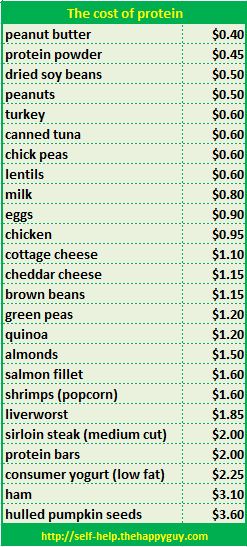Protein is one of the most important nutrients in our diet. It is the one responsible for growth and bodily repair. It is also one of the most expensive nutrients, which is why the protein part of your meal (the meat) costs the most.
But wait! Not all protein is as expensive as your filet mignon.
So I set out to put together a short study of the various sources of protein readily available and their cost, as much for my own use as for blogging here. The goal is to find out how I can get a complete serving of protein for under a dollar.
I used the assumption that a complete serving is 20 grams, although you might want more right after a workout…and also you should have some between meals, because 60 grams of protein per day is pretty low.
Before reporting the results of my study, I must offer two big caveats:
- First, I am strictly reporting on the cost of various sources of protein. I am not judging the value of the sources, some of which might have a lot more fat or sodium than others, or a lot more other important nutrients than others.
- Second, prices vary. They vary from store to store. They vary over time. They vary from brand to brand or even from package size to package size. I attempted to report pricing based on the most common package size available at regular grocery stores. Specialty stores might sell for more, discount stores for less – and, of course, you can always get your protein for less by watching for sales, couponing and all the other sorts of things that a frugal-minded shopper will do.
One last thing before reporting the results, because I really need to get this off my chest…

Well, now that that’s over with, here are the results:

So you can see that there are several fairly frugal alternatives to steak. For instance, making a milk shake or a smoothie with protein powder allows you to control both the taste and the levels of other nutrients. I often add some protein powder to “milk shakes” (mostly fruit, some milk and just a little ice cream) as a snack for my kids.
Peanut butter is also quite inexpensive, although pretty high in fat. Peanut butter on a whole grain bread gives a nice between-meals level of protein.
Do you enjoy mixed nuts? Very healthy, great for protein, but not great for fat if you eat too much of them. Make sure you have plenty of peanuts and dry soy beams in the mix – a great frugal way to add protein, and the soy beans will dilute the overall fat content.
READ ALSO: Get a $1000 Raise With Your Personal Fast Food Outlet
Turkey and canned tuna are still the cheapest meat sources of protein. Both make great sandwiches or great salad toppings.
Chick peas and lentils are both also quite cheap and very healthy. Both go well in pretty much any salad or soup, and most meat dishes. The only problem with them is that to get enough protein form them alone, you would have to eat an awful lot. However, they are not complete sources of protein, so they would need rice or bread or some other grain with them, anyway.
Rounding out the under-a-dollar sources of protein are eggs, milk and chicken. Most people drink milk anyway for the vitamin D and the calcium, but it can also be a great source of between-meals protein. Chicken is very similar to turkey, but usually pricier (although often on sale – hint, hint). And eggs are packed with other nutrients, too, and if you don’t mind it turning out more like scrambled eggs, you can usually squeeze more veggies into an omelet than eggs.
As for the rest of the protein sources, some of them are also very healthy in many ways, but they will cost more. So if you are committed to frugal, there is only one thing you can do about these – watch for coupons and specials.


